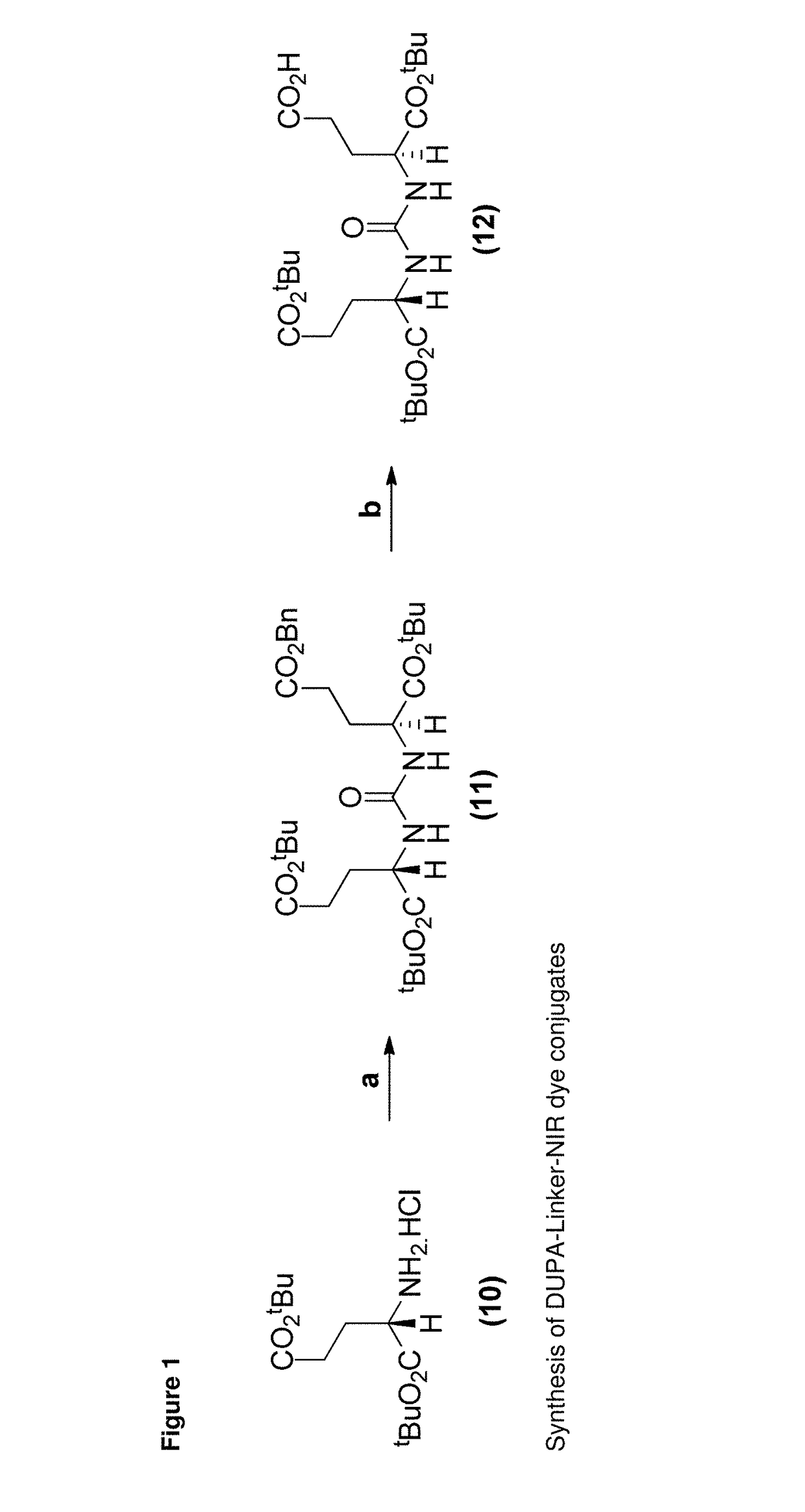PSMA-targeted NIR dyes and their uses
a technology of prostate specific membrane and dye, which is applied in the direction of fluorescence/phosphorescence, drug composition, peptide, etc., can solve the problems of osteoporosis and liver damage, use of hormonal drugs is often accompanied by side effects, and affect the quality of life of patients, etc., to improve clinical properties, improve fluorescence, and accelerate tumor accumulation
- Summary
- Abstract
- Description
- Claims
- Application Information
AI Technical Summary
Benefits of technology
Problems solved by technology
Method used
Image
Examples
examples
Example (1): Pre-Clinical Evaluation of PSMA-Targeted NIR Dye Conjugates with Random Variation of Length of the Linker / Spacer Between the Ligand and the NIR Dye
[0411]
[0412]
[0413](a) In Vitro Studies.
[0414]FIG. 2 shows Structure of PSMA-targeted DUPA-FITC (Fluorescein isothiocyanate) conjugate (14) and its binding affinity (KD) and specificity on PSMA-positive 22Rv1 human prostate cancer cells and on PSMA-negative A549 human alveolar basal epithelial cells in culture. DUPA-FITC dissolved in RPMI medium was added at the indicated concentrations to 22Rv1 or A549 cells in RPMI culture media and allowed to incubate for 1 h at 37° C. Media was then removed, washed with fresh media (3×), and replaced with PBS (phosphate buffered saline). Samples were analyzed using flow cytometry. Error bars represent SD (n=3). ** does not bind to A549 cells
[0415]FIG. 3 Relative binding affinities of DUPA-NIR conjugates 1-9 with respect to DUPA-FITC (14). PSMA-positive 22Rv1 human prostate cancer cells wer...
example 2
cal Evaluation of PSMA-Targeted NIR Conjugates with Aromatic Amino Acid Linkers Between the Ligand and the NIR Dye
[0424]FIG. 6 shows the structures of PSMA-targeted DUPA-Linker-NIR imaging agents with aromatic amino acid linkers between the ligand and the NIR dye. The synthesis scheme is shown in scheme 3.
[0425](b) Synthesis
[0426]
[0427]In Vitro Studies.
[0428]FIG. 7 shows the Relative binding affinities of DUPA-NIR conjugates with aromatic amino acids linkers with respect to DUPA-FITC (14). PSMA-positive 22Rv1 human prostate cancer cells were incubated for 1 h at 37° C. in the presence of 100 nM DUPA-FITC with increasing concentrations of DUPA-NIR conjugates. Media was then removed, washed with fresh media (3×), and replaced with PBS. Cell bound fluorescence was assayed as using flow cytometry.
[0429]Table 2 shows data of the binding affinity of DUPA-NIR conjugates with aromatic linkers to PSMA-positive 22Rv1 human prostate cancer cells.
[0430]
CompoundKD (nM)154.9237.5256.32722.2323233...
PUM
 Login to View More
Login to View More Abstract
Description
Claims
Application Information
 Login to View More
Login to View More - R&D
- Intellectual Property
- Life Sciences
- Materials
- Tech Scout
- Unparalleled Data Quality
- Higher Quality Content
- 60% Fewer Hallucinations
Browse by: Latest US Patents, China's latest patents, Technical Efficacy Thesaurus, Application Domain, Technology Topic, Popular Technical Reports.
© 2025 PatSnap. All rights reserved.Legal|Privacy policy|Modern Slavery Act Transparency Statement|Sitemap|About US| Contact US: help@patsnap.com



